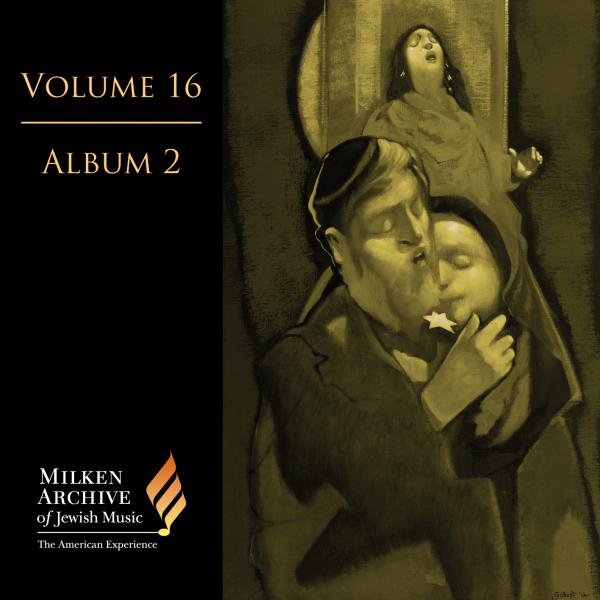Tracks
Track |
Time |
Play |
| My name is Jacob | 03:47 | |
| When are we going, father? | 06:19 | |
| Thou has ravished my heart | 06:11 | |
| How strange, how in a dream I see it all | 07:54 | |
| They leave me, one by one | 05:00 | |
| Who, who are you stranger? | 04:10 | |
| Are we ready for the meeting with Esau? | 03:03 | |
| Brother... | 04:01 |
Liner Notes
Samuel Adler’s The Wrestler, a music-drama in one act to a libretto by Judah Stampfer, is an operatic interpretation of the biblical account of Jacob’s wrestling with the angels and of his multitiered relationship with his older brother, Essau—against whom Jacob and his mother, Sarah, conspired to wrest his birthright and obtain the blessing of his father, Isaac.
The Wrestler represents Adler and Stampfer’s reimagining of this account in humanistic terms of reconciliation and human conscience. In part this is a reflection of 1960s and early 1970s sensibilities, with its focus on “finding oneself” and coming closer to one’s fellow human beings. Adler saw the work as “examining the innermost soul and the sources of energy that drive one on [Jacob]...and, in the process, finding and understanding the self. In finding the self, one finds his fellow man.” To some extent, this focus seems to reflect some of the Eastern religious-philosophical strains that had become popular at that time among American artists and intelligentsia.
It is the psychological impact of this biblical story that interested Adler and Stampfer. For them, its core is Jacob’s reunion with his brother—and their reconciliation.
Throughout the opera Jacob is torn (“crazed,” in Adler’s words) with conflicting emotions and preoccupied with the realization that he was complicit in stealing Essau’s birthright and in deceiving their father. In Adler’s direct assessment, Jacob knows that “in his youth he had been a thief and a cheat.” Here, he returns as a mature, troubled man. For the composer and the librettist, the wrestling match with the angels is as much psychological as real; Jacob is actually wrestling with himself—with his conscience and his soul. He wrestles, in 1960s and ’70s Eastern wisdom-tinged parlance, to “find who and what he has become—who he is now.” The result is a transformed attitude when he comes to meet his brother. He feels guilty and regretful over the estrangement; Essau does not. In an interview that preceded the opera’s broadcast by the opera department of the Eastman School of Music, conducted by the composer (the live recording of which is included in the Milken Archive), Adler pointed out that even though traditional Judaic commentary emphasizes the basic goodness of Jacob and the unworthy nature of Essau, at this moment of reunion “the two are equal in merit. They both come to this point matured. The years have taken their toll on both of them, and they come wanting to be reunited and to be brothers again."
Thus, he acknowledged, all the anxiety is rather anticlimactic at the end. “We have just a very brief scene of reconciliation,” he observed, “lending the action a fast pace; but then, it stops suddenly.” In fact, Adler acknowledged that this had been one of the criticisms of the opera—that the ending is so shocking and that it ends so abruptly.
The story is told in a series of incidents, both in their normal order and through flashbacks. The work calls for three choruses: a children’s chorus, representing Jacob’s children; a women’s chorus, representing Essau’s many wives and concubines; and a men’s chorus, used only for a brief moment toward the end, representing Essau’s array of followers—in effect, his army. At one point the children’s chorus also provides a flashback, since the libretto is not only a direct, continuous story line leading to the wrestling match but also a recollection of moments of Jacob’s life: his stealing of Essau’s birthright, meeting Rachel at the well, and the turning point when he finds himself at the place called, in the Bible, bet el (Beth El; lit., house of God), where he sees the angels ascending and descending the ladder. That moment is represented in the opera by what the composer calls a hymn-like song sung by the children, who represent the angels in that scene.
Adler views the opera in ideally Wagnerian terms of Gesamkunstwerke—an artistic, literary, and philosophical totality, where the words, the layers of meaning behind the story, and the literary and psychological elements are equal to the music in importance.
The Wrestler was commissioned by the American Guild of Organists for its 1972 convention in Dallas. The guild, whose membership includes many church organists, was particularly interested in an opera of religious underpinning and nature. At that period, there had emerged a general interest in theater—particularly religiously based theater—within church circles of many denominations, especially in the South and Southwest. Opera was just one manifestation of that interest. The Wrestler was performed three times during the convention.
This opera was written with a view to staging outside the conventional opera house setting: in the round or in church or synagogue venues. In fact, Adler felt that a proscenium could detract from the work’s intimacy. The Eastman production was staged in the round, and Adler felt that it thus enabled the audience “to be involved—in the sense of being, as listeners, right in the middle of the action.”
Credits
Composer: Samuel AdlerPerformers: Samuel Adler, Conductor; Celina Cornet, Soprano; Tonio DePaolo, Baritone; Eastman Children's Choir; Eastman Chorus; Eastman Opera Theatre Orchestra; Jayna Ellum, Mezzo-soprano; John Oliver, Bass Baritone
Additional Credits:Publisher: Oxford University Press
